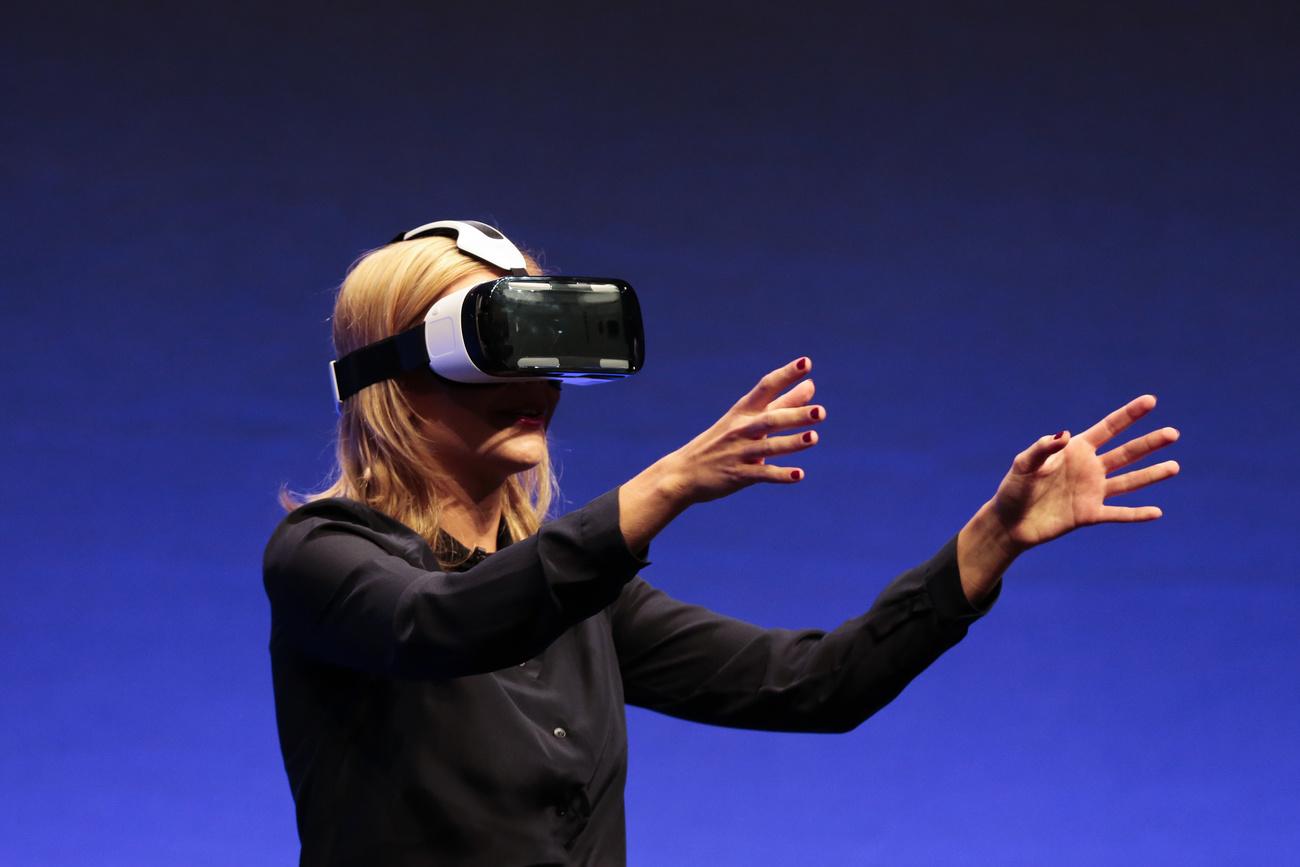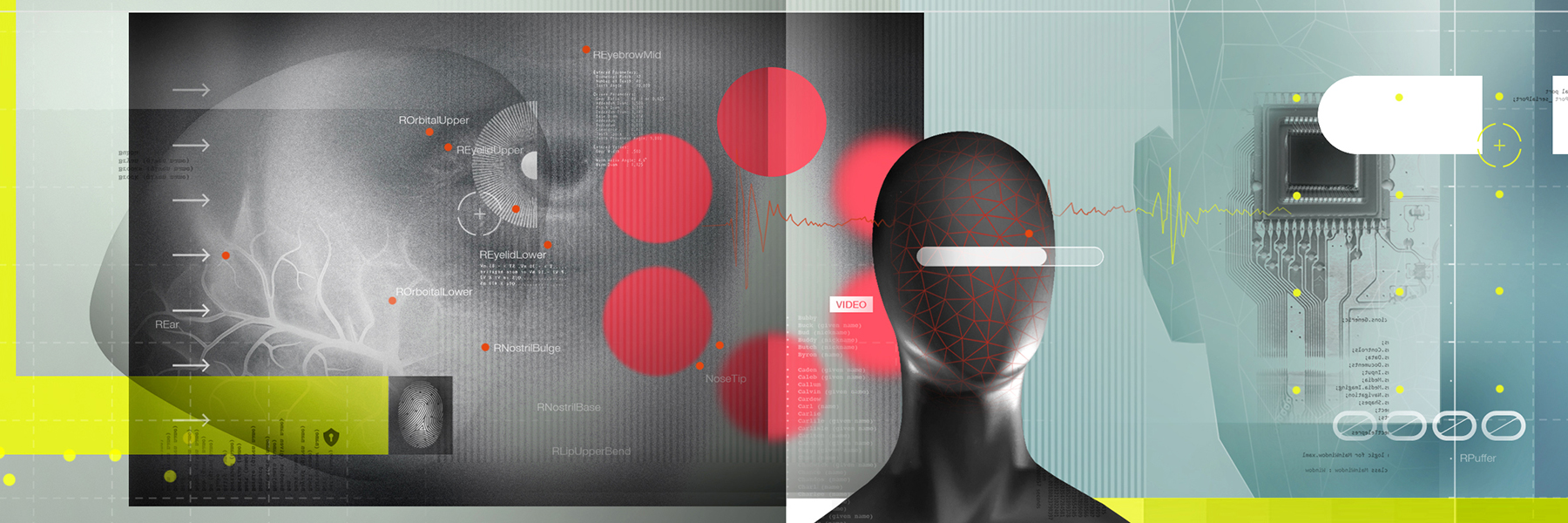
Nausea-free VR: how far has research progressed?

The tech sector is hoping for major profits from the metaverse, as shown by Apple's Vision Pro and Meta's Quest 3. Yet many people feel sick when they put on the goggles needed to move around this virtual world. Researchers in Switzerland are working on solutions to the problem.
Luca Surace puts on Oculus goggles with headphones. The screens in the goggles show him a roller-coaster. Not just any kind, but a kind that could not even exist in the real world. With hair-raising loops and steep curves, it travels somewhere high above the ground.
For the duration of this virtual roller-coaster ride an eye tracker measures where exactly Surace looks. Using a joystick the doctoral student can record how nauseous he feels at any given moment.
Surace hits ten, the maximum value, a few times. After the experiment is finished, he needs to go out for a breath of fresh air. Surace was feeling what is known in the field as cybersickness, or virtual reality (VR) sickness.
His professor Piotr Didyk at the University of Italian Switzerland in LuganoExternal link leads a research team studying this problem. “What interests me is how people perceive images,” he says.
An earlier experiment involved 25 volunteers. Three of them needed to get off the virtual roller-coaster early because they felt so bad. They experienced extreme motion sickness even though they were sitting stilll. Others endured dizziness, headaches, tiredness and sweating.
For the tech juggernauts this is a problem. Meta, the new name of Facebook since 2021, has invested extensively in developing the metaverse, which is defined as an immersive digital platform aimed to facilitate human interactions in real time. Microsoft is now investing even more than Meta in the current year. Google External linkis in third position.External link
Our video from Lugano:
Cybersickness is common
A quick press review shows that cybersickness is by no means an unusual occurrence. A journalist with the business newspaper HandelszeitungExternal link who was at the World Economic Forum (WEF) reported that she felt sick when she took part in the presentation of the virtual “Global Collaboration Village” and looked down from the virtual hot-air balloon she was riding.
Another journalist from the NZZ Folio magazine tested out life in the metaverseExternal link for a period of several days. “Most of the time my big fear was getting sick on the floor,” she reported.
If the metaverse is to be a success, the major tech players will have to find some solutions here. They are hoping research institutions will come up with the answer.
Breakthrough study in Zurich
“Cybersickness has been one of the main impediments to the widespread adoption of Virtual Reality for decades,” according to researchers at the Sensing, Interaction & Perception Lab at the Federal Institute of technology in Zurich (ETH) in a study presented at a conference last year. With 837 volunteers taking part, this was the biggestExternal link field study so far in the area of cybersickness.
Volunteers between the age of 18 and 13 were all tasked with navigating a virtual social setting. They had to move around in a virtual ballroom, avoid contact with a group of wedding guests who were there, while also finding particular people to interact with them. After each session they were to report any cybersickness experienced.
“The results show that the female participants, and any with very little experience of VR, experienced greater degrees of cybersickness”, reports Professor Christian HolzExternal link, who led the study. On the other hand, there was no significant correlation between age and cybersickness.
The current working assumption is that cybersickness is likely to manifest itself when VR programmes cause a discrepancy between what the eyes are seeing and what the inner ear is registering. This affects the vestibular system, which looks after our sense of balance.
The symptoms felt in the virtual ballroom increased the longer participants spent in the virtual environment and the more they moved around in that virtual world – till it reached a peak and then declined, says Holz.

More
The ethics of artificial intelligence
Metaverse makes slow progress
The fact that so many people are feeling nauseous when they move through virtual spaces has prevented the widespread adoption of the metaverse. The major players in the tech world are nonetheless continuing with development and giving this line of work priority.
The technology involved is still open to many questions, notes Guido Berger, digital editor at the Swiss national broadcaster SRF. “Everyone familiar with the technology would now agree that the big breakthrough isn’t coming anytime soon. In 10 or 15 years we may have it mastered.”
Market research firm Gartner deduces from its “hype cycle”External link that it will take at least ten years for the metaverse to be perfected.
Here is one example of VR use from Switzerland. The Institute of Financial Services in Zug, which belongs to LucernExternal linke University of Applied Sciences, held an event last autumn together with the Lucerne Cantonal Bank at which bank customers participated in an hour-long meeting in the metaverse.
The time spent in the virtual world was more demanding that an ordinary meeting and was rather tiring, participants reported. The Institute had to restrict the number of participants in this metaverse meeting because “considerable bandwidth” is needed to connect more headsets, according to a brief on the meeting.
Why Switzerland matters for VR
Switzerland has a leading role in Virtual Reality. VR headsets and the technology needed to make the metaverse work are being developed at Meta’s offices in ZurichExternal link. 300 staff are working on these projects at the Swiss location.
Meta was unwilling to reveal how much of the work going on in Zurich has to do with cybersickness. Last March, Meta announced a further cut in employee numbers amounting to 10,000 worldwideExternal link, following an initial cull of 11,000 jobs in November. Whether the Swiss location will be affected is not yet known.
The business world has high expectations for the virtual parallel world known as the metavers. Companies are looking forward to a virtual marketplace that will boost their sales. Besides e-commerce, gaming and entertainment, education and health-care applications and activities in the arts are also envisaged.

What needs improving?
Ultimately, the aim has to be to develop a VR headset that’s so light users forget they have it on. And the experience should no longer be stomach turning. These are the issues Didyk and his team are working on, with the help of some financial support from Meta. “The question is, how we can produce the images within the headset so that we get the best quality possible,” he says.
Didyk believes that cybersickness can be prevented through intelligent design of the applications. The causes – beyond the discrepancy between eyes and inner ear already mentioned – are mostly technical in nature: poor image resolution, slow transfer of movements to the screen (latency), and a low display refresh rate.
Didyk shows one example of an improvement for VR headsets. To put it simply, “foveated rendering” depends on the fact that our field of vision is fairly limited and it is enough for an image to be sharp just in the middle of that field – that is, the place where the eye is looking. The goggles can do that with eye-tracking.
While the data are reduced at the periphery of the field of vision, there can be more data and therefore a better resolution in the middle of the image. That will lead to a more comfortable visual experience, Didyk believes.
Other applications currently being researched internationally include more powerful computers, vibrators around the neck which distract a bit from the immersion, and VR goggles with optical stabilisers or better eye-tracking.
Another approach comes from neuroscience. Various studies showExternal link why women have more trouble with cybersickness than men. They have a smaller inter-pupillary distance. Once this was adjusted for in the VR goggles, there were no more differences between men and women.
Holz of ETH mentions another possibility for curing oneself of nausea in virtual worlds. “One of the most effective strategies against cybersickness is to take breaks,” he says. So users may just need to come back to the real world for an occasional time out from the powerful images of virtual reality.
Christian Raaflaub, swissinfo.ch
Edited by Sabrina Weiss
Translated from German by Terence MacNamee

In compliance with the JTI standards
More: SWI swissinfo.ch certified by the Journalism Trust Initiative
















![The four-metre-long painting "Sonntag der Bergbauern" [Sunday of the Mountain Farmers, 1923-24/26] had to be removed by a crane from the German Chancellery in Berlin for the exhibition in Bern.](https://www.swissinfo.ch/content/wp-content/uploads/sites/13/2025/12/01_Pressebild_KirchnerxKirchner.jpg?ver=bb19e376)















You can find an overview of ongoing debates with our journalists here . Please join us!
If you want to start a conversation about a topic raised in this article or want to report factual errors, email us at english@swissinfo.ch.